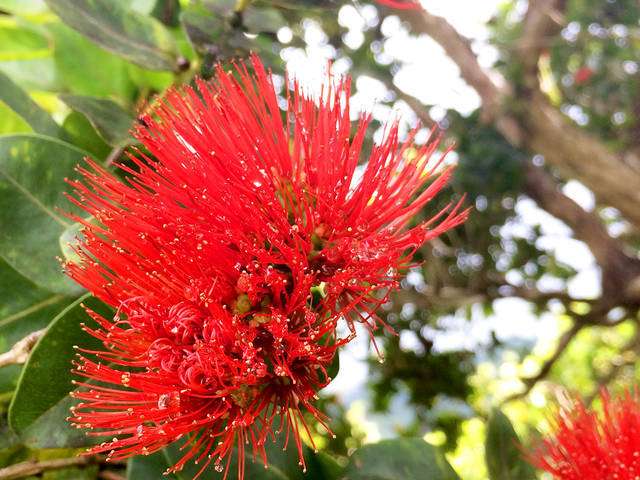LIHUE — Lava flows have wiped out the first Hawaii Island ohia trees with the pathogen that causes rapid ohia death (ROD).
And scientists say though it’s not a cure-all for spread of the disease, it is a little bit of a silver lining in a natural disaster that has destroyed more than 700 homes on Hawaii Island since Kilauea volcano started erupting in May.
“The Leilani Estates/Puna area was one of the larger widespread outbreak areas of ROD and the first area ROD and the fungus ceratocystis was detected in 2014,” said Lisa Keith, who is researching ROD with the U.S. Department of Agriculture Research Station. “The fungal pathogen was still present in many infected trees in the areas which have been destroyed by lava, which ultimately prevents the spread of ROD.”
But the lava hasn’t taken out all of the pathogen, which has spread significantly from its Leilani Estates origin.
“That area was the worst hit area, but it spread far beyond that,” said JB Friday, ROD statewide outreach coordinator and extension forester for University of Hawaii, College of Tropical Agriculture and Human Resources. “It hasn’t been knocked out. If this had happened five years ago, then I would have said ‘Hey, it took out half the area.’”
There are two types of fungus that cause ROD: Ceratocystis huliohia is less aggressive than ceratocystis. Both are found on Hawaii Island.
In May, five trees were found dead in Kauai’s Moloaa Forest Reserve by state Department of Land and Natural Resources’ botanist Adam Williams. Tests show they have the less aggressive form of ROD.
That discovery has triggered more intense surveillance, data collection and research to determine the extent of the ROD fungus on Kauai.
Keith says there haven’t been any more outbreaks discovered on any of the islands since May, and the outbreak in Moloaa’s status hasn’t changed.
“The trees containing C. huliohia, the less aggressive of the two ROD pathogens, in the Moloaa Forest Reserve had been dead for quite some time,” Keith said.
Research is ongoing surrounding both types of ROD fungus. Currently Keith and her team are making genetic comparisons between the C. huliohia on Kauai and that same pathogen on Hawaii Island.
And while scientists do their work to help prevent and stop the spread of ROD through Hawaii’s ohia trees, DLNR officials and researchers alike ask the public to not add to the problem.
“Biosecurity and sanitation to prevent this much-more-aggressive pathogen on Kauai is really important,” Friday said. “The more-aggressive fungus, you don’t want it on Kauai.”
It’s important to make sure you don’t injure an ohia tree when you’re out in Kauai’s forests, he explained, which means pruning or chopping — anything that’ll leave a mark on the bark of the tree.
Livestock and land clearing can damage trees as well, but picking a flower won’t break the bark and scientists say that most likely won’t impact the trees.
Removing any wood off of Hawaii Island, unless it’s kiln-dried lumber or has been inspected, is also off-limits because the fungus could be in the wood.
“Biosecurity, it’s not a joke,” Friday said. “People think they’re being funny or that they’re clever and smuggle wood out, but we’re serious about not moving ohia wood over to Kauai. It could be really bad.”
Travelers are also urged to clean their boots and shoes with alcohol when returning to Kauai, to prevent the spread of the fungus between the islands.
•••
Jessica Else, environment reporter, can be reached at 245-0452 or jelse@thegardenisland.com.


